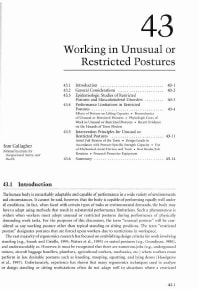Mining Publication: Working in Unusual or Restricted Postures
Original creation date: February 2006
Authors: S Gallagher
NIOSHTIC2 Number: 20030485
Interventions, Controls, and Applications in Occupational Ergonomics (the Occupational Ergonomics Handbook), 2006 Feb; Marras WS, Karwowski W, eds., Boca Raton, FL: CRC Press, 43.1-43.16
The human body is remarkably adaptable and capable of performing in a wide variety of environments and circumstances. It cannot be said, however, that the body is capable of performing equally well under all conditions. In fact, when faced with certain types of tasks or environmental demands, the body may have to adapt using methods that result in substantial performance limitations. Such a phenomenon is evident when workers must adopt unusual or restricted postures while performing physically demanding work tasks. For purposes of this discussion, the term "unusual posture" is considered as any working posture other than typical standing or sitting positions. The term "restricted posture" denotes postures that are forced upon workers due to restrictions in work space. The vast majority of ergonomics research has focused on establishing design criteria for work involving standing or seated postures, and understandably so. However, it must be recognized that there are numerous jobs (e.g., underground miners, aircraft baggage handlers, plumbers, agricultural workers, mechanics, etc.) where workers must perform in less desirable postures, such as kneeling, stooping, squatting, and lying down. Unfortunately, experience has shown that many ergonomic techniques used to analyze or design standing or sitting work stations often do not adapt well to situations where a restricted posture is adopted. However, recent years have seen an increase in research examining the musculoskeletal risks and physical limitations associated with working in these postures. This chapter summarizes current knowledge in this area and establishes principles for ergonomic design of jobs when working in unusual or restricted postures.

NIOSHTIC2 Number: 20030485
Interventions, Controls, and Applications in Occupational Ergonomics (the Occupational Ergonomics Handbook), 2006 Feb; Marras WS, Karwowski W, eds., Boca Raton, FL: CRC Press, 43.1-43.16